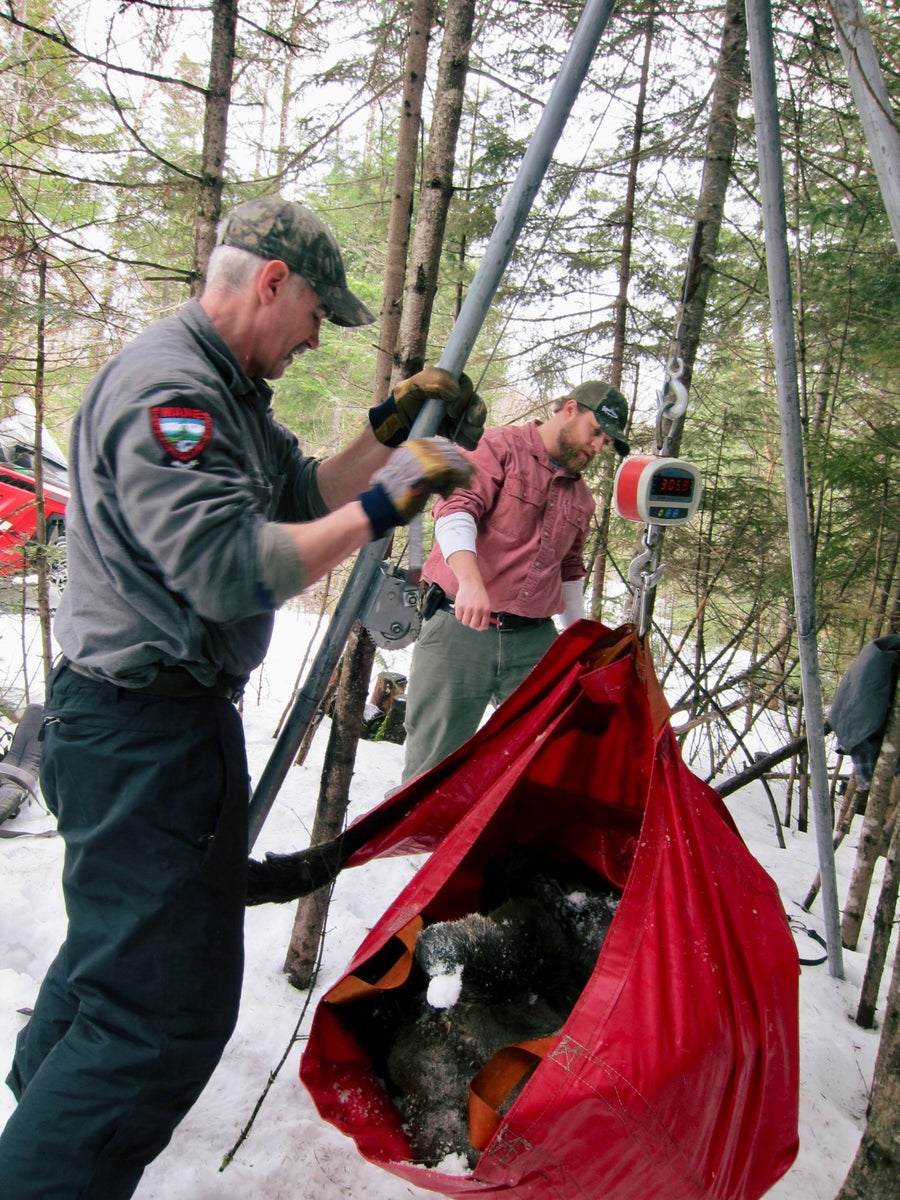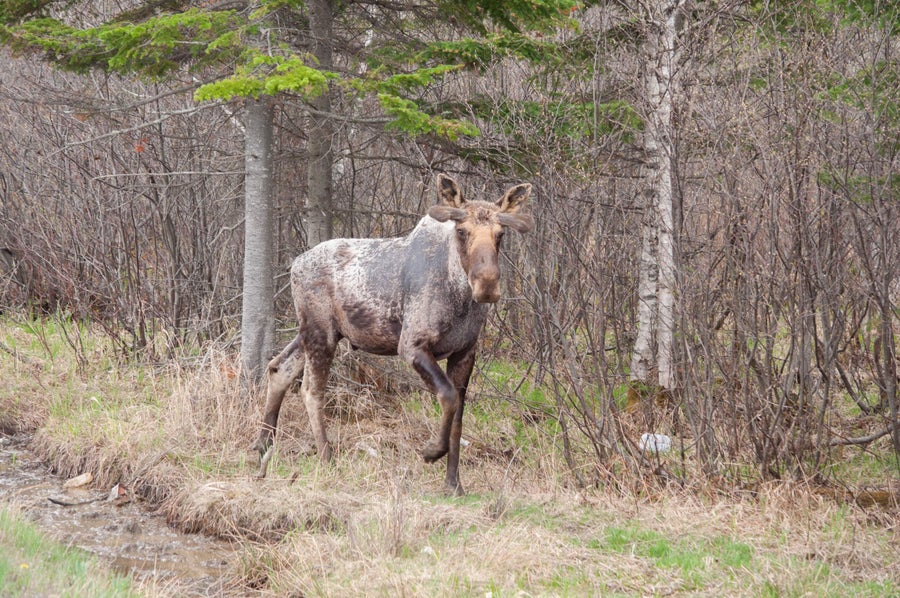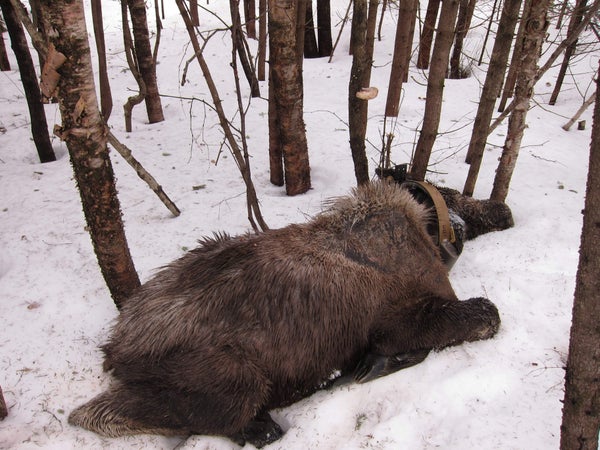Amid lightly falling snow on a gray April morning, Lee Kantar crouches over a dead moose calf. Its head rests on the ground and its legs are tucked beneath its frail torso. A GPS collar Kantar had strapped around its neck in January pinged his phone the night before, signaling the calf had not moved in more than six hours and was likely dead. “Nose is normal. Eyes are normal. Ears are normal—quite a bit of ticks on her ears,” Kantar calls off to his field assistant, Carl Tuggand, who records the data on a clipboard. “There are a lot of ticks on her.”
Responding to tick-covered dead moose has become a regular springtime routine for Kantar; as Maine’s official state moose biologist at its Department of Inland Fisheries and Wildlife, he has strapped necropsy equipment to his snowmobile and bushwhacked through dense forests dozens of times over the past five years. He is studying how growing infestations of winter ticks have seized entire populations of this iconic animal. As climate change shortens winters and improves living conditions for these ticks—which do not carry Lyme or other human-harming diseases—their population size and range have begun to expand. Now scientists in Canada have embarked on a similar five-year study in New Brunswick and Quebec to document how moose there are being affected as the raisin-size parasites spread northward. The researchers seek to slow this expansion and figure out ways to bolster moose populations. For eastern Canada, “it’s a new phenomenon,” says study leader Steeve Côté, a biologist at Laval University in Quebec City, “and people are highly concerned about it.”
.jpg?w=900)
Winter ticks latch onto a host in the fall and take blood meals from it until the following spring. These ticks do not carry Lyme or other diseases typical of other species. Credit: Laura Poppick
On supporting science journalism
If you're enjoying this article, consider supporting our award-winning journalism by subscribing. By purchasing a subscription you are helping to ensure the future of impactful stories about the discoveries and ideas shaping our world today.
Tick Explosion
Moose numbers have declined roughly 10 percent in Maine and as much as 50 percent in New Hampshire since the early 2000s; Kantar and his colleagues in New England attribute this largely to a climate change–linked explosion in winter tick populations. In a recent Canadian Journal of Zoology study they report three consecutive years of tick epizootics (epidemics among animals of the same species) from 2014 through 2016—a run they say is unprecedented in this region. The ticks have become so voracious in some places a single moose can carry an appalling 90,000 at once, they report. In such numbers the ticks drain so much blood that the host moose can become anemic and malnourished and “can’t replace the blood fast enough,” Kantar says. In the case of many first-year calves like the one Kantar responded to in April, they die.
Not all populations across Maine have suffered at the same rate—calves in Kantar’s northeastern study region are doing better than those in the state’s west, possibly due to the earlier onset of winter in the northeast. But as winters shorten across the state, survival rates may continue to drop in both regions. This is because ticks “quest” (search for hosts) in the fall and stop once freezing temperatures settle in. As winter continues to arrive later everywhere, the time window for moose to pick up ticks stays open longer, Kantar notes.
Increasingly warmer and snow-free springs also mean female ticks that fall off their hosts can more easily survive to lay nests of larvae that emerge in the fall, says Helen Schwantje, a veterinarian for British Columbia’s Ministry of Forests, Lands, Natural Resource Operations Wildlife Management. The resulting decline in moose populations leaves holes in the cultural landscape as well as the ecological one, Schwantje says. “They have huge cultural and nutritional value to our First Nations,” she says. And when moose forage in wetlands, they help release nutrients into the environment and make them available to other plants and organisms, studies have shown.
Schwantje says the worrying growth of winter tick infestations in British Columbia has now spread to populations of boreal caribou—an alarming sign the ticks are infiltrating species and ranges they have not significantly occupied in the past. Boreal caribou are already listed as a threatened species, and the increased threat of ticks is “just one more thing they have to deal with,” Schwantje says.
If blood loss from heavy tick loads does not directly kill animals, it can make them susceptible to other health risks, Schwantje adds. “They have spent so much time scratching and chewing on themselves that they haven’t been feeding, so they are in poor body condition,” she says. Indeed, the moose calf Kantar responded to in April had lost nearly 100 pounds in the three months since he had collared her—a common scenario, Kantar says.
Hunting Moose to Help Them
To tease out how ticks impact moose health compared with other threats, Côté’s team in eastern Canada plans to attach GPS collars to 300 moose beginning in January 2019 in what he calls the largest-scale moose study of its kind. The team will target animals throughout New Brunswick and Quebec, treating half of them with anti-parasite gel and pills that make attached ticks drop from their bodies. This will help isolate the impacts of ticks from other factors including habitat quality, predators such as wolves and pressure from other parasites.

Lee Kantar and field assistant Carl Tuggand hoist a recently deceased moose calf on a tripod to document her weight at death. They gather a series of other data points during their routine necropsies to track how ticks might be impacting moose populations. Credit: Laura Poppick
The researchers’ work will identify the types of habitats that promote ticks—information that could help develop forestry practices that thwart tick populations, Côté says. For example, ticks seem to do better in deciduous forests than coniferous ones because the ground is more shaded—and therefore cooler—in dense coniferous stands. “They are quite sensitive to temperature,” Côté says, adding existing logging operations could possibly amend their practices to maintain cooler, less ideal conditions for ticks—although his team will not make any official recommendations before carrying out their research.
Peter Pekins, a wildlife ecologist at the University of New Hampshire and Kantar’s collaborator, suggests an alternative that may seem counterintuitive: issuing more moose-hunting permits in strategically selected areas. Thinning moose numbers could, theoretically, starve out pockets of ticks. “The quickest way to get back to a balance may be to reduce moose density,” he says. “That’s the one thing we can control.”
The key, Kantar says, would be to find the right number of hunting permits that would force tick numbers down but still maintain a healthy moose population. Côté agrees this approach could work in the short term but may not be able to keep pace over a longer period if climate change continues to increasingly favor ticks. In his new study he will evaluate this tactic by looking at whether smaller moose populations really do correlate with lower tick loads.
Schwantje says this research will offer insights into managing moose populations, as the cumulative stressors of ticks and landscape changes across the continent increasingly lead to moose declines. Côté remains optimistic his own work and that of his New England colleagues will help address the problem, but acknowledges there may not be an easy solution. “Maybe at the end there is nothing we can do,” he says. But if they discover anything they can do to help the moose, “then that will be a bonus.”

Tick-infested moose often lose large patches of fur as they rub their hides on trees to try to remove ticks. The resulting hair-loss pattern gives them the nickname “ghost moose”. Credit: Joanna R. Ennis
